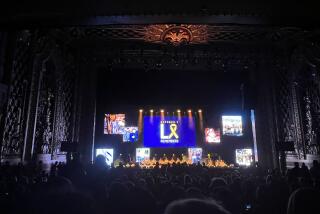L.A. Church Joins Mandela Revelry : Reaction: Southland activists hold an all-night vigil to celebrate the events in South Africa.
- Share via
They had waited throughout the night and into the dawn Sunday at Los Angeles’ First African Methodist Episcopal Church. When the moment came, shortly after 6 a.m. here, it was as sweet as promised.
As the image of a freed Nelson R. Mandela flashed on TV screens in First AME’s crowded annex, the roomful of revelers surged. First came a deafening cheer, then fists started pumping into the air.
A cappella strains of the black anthem “Lift Every Voice and Sing” were drowned out by shouts of “Free at last, Mandela!”
Half a world away, amid a similar throng of South African supporters, Mandela looked up, smiled, then waved.
The image of the African National Congress leader walking away from his Cape Town prison evoked tears from many of the 200 anti-apartheid activists who huddled around television sets at the church in Los Angeles’ West Adams district.
At every glimpse of the 71-year-old man whose plight had become a symbol of oppression suffered by black South Africa, the group cheered.
The room then slipped into a graceful sway that matched the rhythm of freedom anthems led by organizers from more than a dozen student and activist groups.
Starting at 6 p.m. Saturday, the gathering had waited for the early-morning release of Mandela. During the night, speakers from around the county and some recently from South Africa described conditions under the government system that kept Mandela imprisoned for more than 27 years.
Walimu Evans, 47, founder of the Nelson R. Mandela Educational Institute in Compton, said she named her nursery and elementary school after the ANC leader because she “was impressed that Mandela stayed true to what he believed.”
“I wanted the kids to learn about sticking with what they believe and that by (doing so) they can eventually succeed.”
Mandela has made an impression on even her youngest students, including Nia Ujamaa, 8, a fourth-grader at the institute who came to the vigil with her godmother.
“I know that he is a freedom fighter and that he was put in jail for trying to help the people who are like slaves in South Africa,” Nia said at about 2:30 a.m. Sunday.
As the girl picked up a sleeping bag and pillow and trooped upstairs to take a nap, she added, “I also know that his being free means the other people can be free too.”
Between speakers during the vigil, an African traditional dance company from Los Angeles provided impromptu performances.
“The world needs a lot of healing,” said Nzingha Camara, director of Le Ballet de Kouman Kele, which specializes in a West African form of “healing dance” called lambda . “Mandela is one who is trying to heal the ills of South Africa. That’s why we wanted to do lambda tonight.”
After the revelry that had surrounded Mandela’s release began to subside, some people voiced words of caution.
“It’s too premature to say that the system is really changing,” said Sam Phillips, 41, a performing arts teacher who left South Africa in 1987. “What (Mandela’s release) does do is signify that a black man can fight to the end. I see it as a sign that the struggle is intensifying.”
Lebo Morake, a member of the student group Themba (Hope), told the audience that the apartheid system that separates its victims according to race must be challenged by all those who are oppressed.
“Unity is our number one weapon,” Morake said. “It is in fact our only weapon.”
After the vigil, celebrations over Mandela’s release continued.
During two crowded church services at First AME, sermons by ministers were sprinkled with references to his release. A choir member interrupted her solo to praise Mandela. After the services, members of the congregation walked through the neighborhood displaying a placard that read: “Mandela Is Free.”
In the afternoon, 300 protesters marched in front of the South African Consulate in Beverly Hills in a demonstration organized by the Southern California chapter of the African National Congress. They covered the front of the building with black, green and gold ANC flags.
Protesters demanded that the consulate vacate its offices and that the City of Beverly Hills rename the building. As the demands were recited, protesters unfurled a banner that read: “Welcome to Nelson Mandela Square.”
More to Read
Sign up for Essential California
The most important California stories and recommendations in your inbox every morning.
You may occasionally receive promotional content from the Los Angeles Times.










